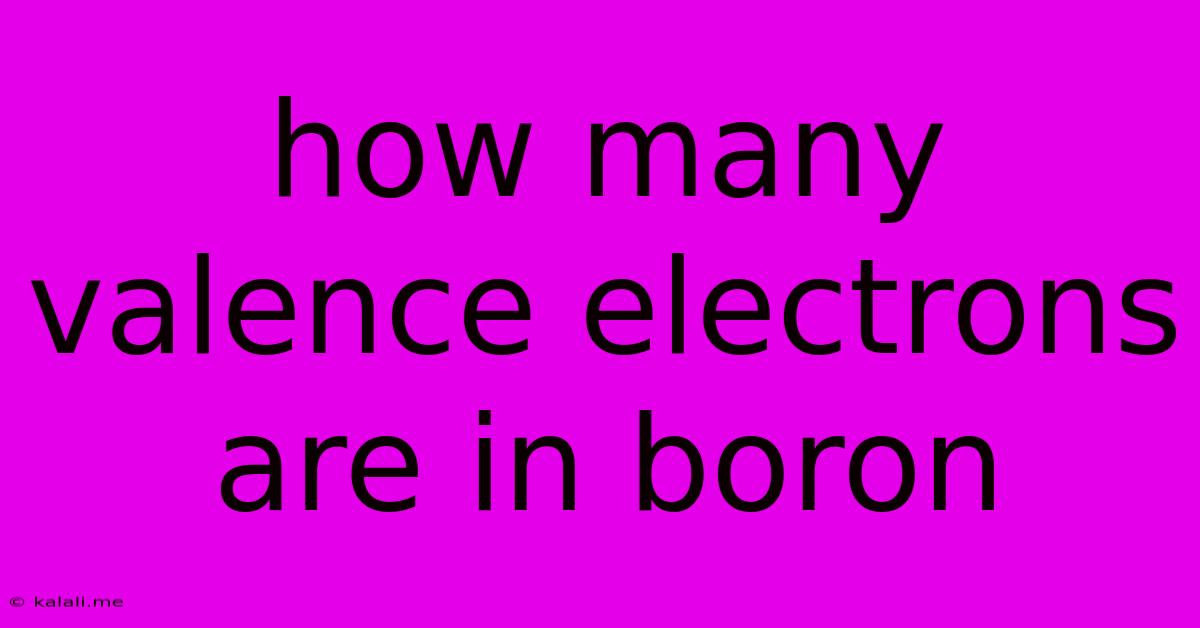How Many Valence Electrons Are In Boron
Kalali
Jun 11, 2025 · 2 min read

Table of Contents
How Many Valence Electrons Does Boron Have? A Deep Dive into Atomic Structure
Boron, a metalloid element crucial in various applications from detergents to semiconductors, possesses a unique atomic structure that determines its chemical behavior. Understanding the number of valence electrons in boron is key to grasping its reactivity and bonding properties. This article will explore this fundamental aspect of boron's atomic structure, explaining what valence electrons are, how to determine them, and why this number is significant.
What are Valence Electrons?
Valence electrons are the electrons located in the outermost shell (also known as the valence shell) of an atom. These electrons are the primary participants in chemical bonding, determining an element's reactivity and the types of bonds it can form (ionic, covalent, or metallic). The number of valence electrons dictates an element's position in the periodic table and its group properties. Understanding valence electrons is fundamental to understanding chemistry.
Determining Boron's Valence Electrons
Boron (B) has an atomic number of 5, meaning it has 5 protons and 5 electrons in a neutral atom. To determine the number of valence electrons, we need to look at the electron configuration of boron. The electron configuration describes how electrons are distributed among the different energy levels and subshells within the atom.
Boron's electron configuration is 1s²2s²2p¹. The electrons fill the lowest energy levels first, following the Aufbau principle.
- The 1s² represents two electrons in the first energy level (n=1).
- The 2s² represents two electrons in the second energy level (n=2), specifically in the s subshell.
- The 2p¹ represents one electron in the second energy level (n=2), specifically in the p subshell.
The outermost shell for boron is the second energy level (n=2). This shell contains a total of three electrons (2s²2p¹). Therefore, boron has three valence electrons.
Significance of Boron's Three Valence Electrons
The presence of three valence electrons explains boron's chemical behavior:
- Covalent Bonding: Boron readily forms covalent bonds by sharing its three valence electrons with other atoms to achieve a more stable electron configuration. This is common in boron compounds like boranes (compounds containing boron and hydrogen).
- Electron Deficiency: With only three valence electrons, boron often exhibits electron deficiency, meaning it doesn't have a full octet of electrons in its valence shell. This leads to unique bonding situations and the formation of electron-deficient compounds.
- Reactivity: Boron's three valence electrons contribute to its moderate reactivity. While not as reactive as alkali metals (Group 1), boron still participates in a range of chemical reactions.
Conclusion:
In summary, boron possesses three valence electrons. This fundamental characteristic dictates its chemical properties, bonding behavior, and role in various compounds and applications. Understanding valence electrons is crucial for comprehending the reactivity and bonding patterns of all elements, and boron serves as a clear example of how valence electron count impacts an element's chemical nature.
Latest Posts
Latest Posts
-
How Many Quarts Are In 18 Gallons
Jul 01, 2025
-
How Old Are You If You Were Born In 2002
Jul 01, 2025
-
How Many Sides Does A Star Have
Jul 01, 2025
-
How Many Ears Of Corn In A Can
Jul 01, 2025
-
What Grade Is A 15 Out Of 20
Jul 01, 2025
Related Post
Thank you for visiting our website which covers about How Many Valence Electrons Are In Boron . We hope the information provided has been useful to you. Feel free to contact us if you have any questions or need further assistance. See you next time and don't miss to bookmark.